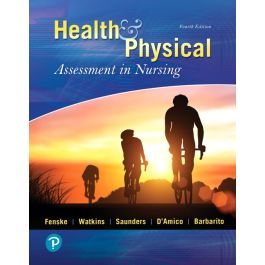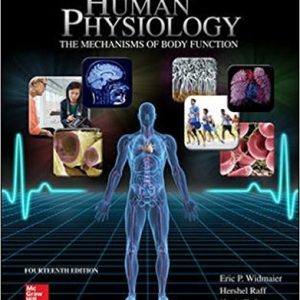This is completed downloadable of Test Bank for Health and Physical Assessment In Nursing 4th Edition by Fenske

Product Details:
- ISBN-10 : 013486817X
- ISBN-13 : 978-0134868172
- Author: Cynthia Fenske, Katherine Watkins, Tina Saunders, Donita D’Amico
Health & Physical Assessment in Nursing helps nursing students master the art, science, and skills of health and physical assessment for the RN. Taking a holistic approach, the text focuses on assessing the whole person and on recognizing the diversity of patients and care settings. It imparts evidence-based knowledge and step-by-step skills alongside discussions of health, wellness, communication, and culture. The 4th edition adds three new chapters that cover the assessment of pediatric and older patients and that prepare students to document both subjective and objective findings.
Table of Content:
- Brief Contents
- Health & Physical Assessment in Nursing
- About the Authors
- Thank You
- Preface
- Organization of this Textbook
- New Chapters
- Features to Help You Use This Text
- Resources for Faculty Success
- Contents
- UNIT I Foundations of Health Assessment
- Chapter 1 Health Assessment
- Learning Outcomes
- Key Terms
- Introduction
- Role of the Professional Nurse
- Teacher
- Caregiver
- Advanced Practice Roles
- Nurse Researcher
- Nurse Practitioner
- Nurse Anesthetist
- Certified Nurse Midwife
- Clinical Nurse Specialist
- Nurse Administrator
- Nurse Educator
- Evidence-Based Practice
- Nursing Process
- Assessment
- Diagnosis
- Planning
- Implementation
- Evaluation
- Health Assessment
- Subjective Data: The Interview
- The Health History
- The Focused Interview
- Objective Data: Physical Assessment
- Documentation and Privacy
- Critical Thinking
- Health and Health Disparities
- References
- Chapter 2 Health and Wellness
- Learning Outcomes
- Key Terms
- Introduction
- Nursing Theory and Foundations
- Models of Health
- Health, Wellness, and Health Promotion
- Definitions of Health
- Definitions and Theories of Wellness
- Definitions of Health Promotion
- Perspectives on Health Promotion
- Health Belief Model
- Theory of Reasoned Action/Planned Behavior
- Health Promotion Model
- Individual Characteristics and Behaviors
- Behavior-Specific Cognition and Affect
- Perceived Benefits of Action
- Perceived Barriers to Action
- Perceived Self-Efficacy
- Activity-Related Affect
- Interpersonal Influences
- Situational Influences
- Commitment to a Plan of Action
- Immediate Competing Demands and Preferences
- Behavioral Outcomes
- Health Promotion and the Nursing Process
- Assessment
- Diagnosis and Planning: The Plan of Care
- Implementation and Evaluation: Roles of the Professional Nurse
- References
- Chapter 3 Cultural and Spiritual Considerations
- Learning Outcomes
- Key Terms
- Introduction
- Culture
- Subdivisions of Culture
- Terms Related to Culture
- Race
- Heritage
- Ethnicity
- Ethnocentrism
- Diversity
- Acculturation
- Assimilation
- Cultural Competence
- Cultural Phenomena That Impact Healthcare
- Temporal Relationships
- Family Patterns
- Dietary Patterns
- Health Beliefs and Health Practices
- Culture in Comprehensive Health Assessment
- Ethnic Identity and Culture
- Spirituality
- Terms Related to Spirituality
- Spiritual Distress
- Spiritual Assessment
- Spiritual History
- Spiritual Care Competence
- References
- Chapter 4 Health Disparities
- Learning Outcomes
- Key Terms
- Introduction
- Health Disparities
- Health Disparities: Considerations for Nursing and Health Assessment
- Factors Influencing Health Disparities in Vulnerable Populations
- Race and Ethnicity
- Age
- Gender
- Sexual Orientation and Gender Identity
- Geography
- Disabilities
- Socioeconomic Status
- Uninsured and Underinsured
- Maternal and Infant Health
- Immigrants and Refugees
- Incarcerated Men and Women
- Veterans
- Homelessness
- Strategies to Reduce and Eliminate Health Disparities
- Healthy People 2020
- Affordable Care Act
- National Partnership for Action to End Health Disparities
- Racial and Ethnic Approaches to Community Health
- References
- UNIT II Techniques for Health Assessment
- Chapter 5 Interviewing and Health History: Subjective Data
- Learning Outcomes
- Key Terms
- Introduction
- The Purpose of the Health History: Subjective Information
- Sources of Information
- Primary Source
- Secondary Sources
- Documenting the Health History
- Interactional Communication Skills and the Health History
- Listening
- Attending
- Paraphrasing
- Leading
- Questioning
- Reflecting
- Summarizing
- Professional Characteristics to Enhance the Nurse–Patient Interaction
- Positive Regard
- Empathy
- Genuineness
- Concreteness
- Barriers to Effective Patient Interaction
- False Reassurance
- Interrupting or Changing the Subject
- Passing Judgment
- Cross-Examination
- Euphemisms
- Unwanted Advice
- Technical Terms
- Sensitive Issues and Uncomfortable Situations
- Cultural Influence and Bias
- Phases of the Health History Interview
- Phase I: Preinteraction
- Environment
- Phase II: The Initial Interview
- Phase III: The Focused Interview
- Components of the Health History
- Biographic Data
- Name and Address
- Age and Date of Birth
- Birthplace
- Marital Status
- Sex and Gender
- Sexual Orientation and Gender Identity
- Race
- Religion
- Occupation
- Health Insurance
- Source of Information
- Reliability of the Source
- History of Present Illness
- Reason for Seeking Care
- Health Beliefs and Practices
- Health Patterns
- Medications
- Past Medical History
- Family Medical History
- Psychosocial History
- Review of Body Systems
- Lifespan Considerations
- References
- Chapter 6 Documentation
- Learning Outcomes
- Key Terms
- Introduction
- Purpose of Nursing Documentation: Communication
- Communication Within the Healthcare Team
- Communication Among Team Members: SBAR
- Future Communication with Other Professionals
- Principles of Nursing Documentation
- Accuracy
- Concise, Precise, Succinct, Professional
- Legal Principles
- Professionalism
- Completeness
- Confidentiality and Patient Protection
- Health Insurance Portability and Accountability Act (HIPAA)
- Training
- Documenting the Comprehensive Patient Assessment
- Documenting the Health History: Subjective
- Documenting the Family Medical History: The Genogram
- Documenting the Physical Examination: Objective
- Charting and Documentation
- Narrative Notes
- Problem-Oriented Charting
- Flow Sheets
- Symptom Assessment Documentation
- Charting by Exception
- Developing Documentation Proficiency
- References
- Chapter 7 Physical Assessment Techniques and Equipment
- Learning Outcomes
- Key Terms
- Medical Language
- Introduction
- Basic Techniques of Physical Assessment
- Inspection
- Palpation
- Light Palpation
- Deep Palpation
- Additional Considerations
- Percussion
- Direct Percussion
- Blunt Percussion
- Indirect Percussion
- Sounds
- Auscultation
- Equipment
- Stethoscope
- Doppler
- Ophthalmoscope
- Otoscope
- Professional Responsibilities
- Cues
- Critical Thinking
- Providing a Safe and Comfortable Environment
- Setting
- Preparation
- Privacy
- Examination Considerations
- Special Considerations
- Techniques and Equipment in Assessment of the Obese Patient
- Standard Precautions
- Hand Hygiene
- Use and Care of Medical Equipment
- Patient Hazards
- References
- Chapter 8 General Survey and Physical Exam: Objective Data
- Learning Outcomes
- Key Terms
- Medical Language
- Introduction
- Components of the General Survey
- Physical Appearance
- Mental Status
- Mobility
- Patient Behavior
- Lifespan Considerations
- Measuring Height and Weight
- Height
- Weight
- Lifespan Considerations
- Measuring Vital Signs
- Measuring Body Temperature
- Factors That Influence Body Temperature
- Routes for Measuring Body Temperature
- Oral
- Rectal
- Axillary
- Tympanic
- Temporal Artery
- Measuring Pulse Rate
- Location of Pulse Points
- Factors That Influence Pulse Rate
- Palpation of the Radial Pulse
- Measuring Respiratory Rate
- Assessment of Respiratory Rate
- Factors That Influence Respiratory Rate
- Oxygen Saturation Level
- Lifespan Considerations
- Measuring Blood Pressure
- Circulatory Factors That Influence Blood Pressure
- Additional Factors Affecting Blood Pressure
- Assessment of Blood Pressure
- Patient Preparation
- Equipment
- The Procedure
- Lifespan Considerations
- Temperature
- Pulse
- Respirations
- The Functional Assessment as Part of the General Survey
- Functional Assessment During the General Survey
- Critical Thinking
- References
- Chapter 9 Pain Assessment
- Learning Outcomes
- Key Terms
- Medical Language
- Introduction
- Definition of Pain
- Physiology of Pain
- Theories of Pain
- Nervous System
- Nociception
- Transduction
- Transmission
- Perception
- Modulation
- Responses to Pain
- Nature of Pain
- Types of Pain
- Concepts Associated with Pain
- Factors Influencing Pain
- Lifespan Considerations
- Race, Ethnicity, Sex, and Cultural Influences
- Environmental Considerations
- Assessment of Pain
- Pain History
- Onset
- Location
- Duration
- Characteristics
- Aggravating Factors
- Relieving Factors
- Treatment
- Impact on Activities of Daily Living (ADLs)
- Coping Strategies
- Emotional Responses
- Behavior and Physiologic Reponses to Pain
- Behavior
- Physiologic Responses
- Focused Interview
- Questions Regarding Onset
- Questions Regarding Location
- Questions Regarding Duration
- Questions Regarding Characteristics of the Pain
- Questions Regarding Aggravating Factors
- Questions Regarding Relieving Factors
- Questions Regarding Treatment
- Questions Regarding Impact on Activities of Daily Living
- Questions Related to Coping Strategies
- Questions Related to Emotional Responses
- Physiologic Responses
- Assessment Tools
- Unidimensional Assessment Tools
- Multidimensional Assessment Tools
- Tool Selection
- References
- Chapter 10 Nutritional Assessment
- Learning Outcomes
- Key Terms
- Medical Language
- Introduction
- Defining Nutritional Health
- Health Promotion
- Nutritional Assessment Factors
- Cultural Considerations for Nutritional Assessment
- Nutritional History
- Diet Recall
- Food Frequency Questionnaire
- Food Record
- Focused Nutritional History Interview
- Physical Assessment
- Anthropometric Measurements
- Height
- Weight
- Body Mass Index
- Height–Weight Tables
- Waist Circumference
- Body Composition Measurement
- Skinfold Measurements
- Midarm Muscle Circumference and Calf Circumference
- Bioelectrical Impedance Analysis
- Near-Infrared Interactance
- Laboratory Body Composition
- Body Fat References or Standards
- Head-to-Toe Physical Assessment
- Biochemical Assessment—Laboratory Measurements
- Nutritional Screening and Assessment Tools
- ChooseMyPlate
- Other Screening and Assessment Tools
- The DETERMINE Checklist
- The Minimum Data Set
- Mini Nutritional Assessment and Subjective Global Assessment
- Malnutrition Universal Screening Tool
- References
- Chapter 11 Psychosocial Health, Substance Abuse, and Intimate Partner Violence
- Learning Outcomes
- Key Terms
- Medical Language
- Introduction
- Psychosocial Health
- Internal Factors That Influence Psychosocial Health
- Genetics
- Physical Health
- Developmental Stage
- Children
- Older Adults
- Physical Fitness
- External Factors That Influence Psychosocial Health
- Family
- Culture
- Geography
- Economic Status
- Additional Factors in Psychosocial Health
- Substance Use Disorders
- Intimate Partner Violence
- Self-concept
- Eating Disorders
- Role Development
- Sexuality
- Interdependent Relationships
- Maltreatment
- Stress and Coping
- Spiritual and Belief Patterns
- Substance Abuse
- Biological Risk Factors
- Biochemistry
- Genetics
- Sociological Risk Factors
- Social Learning and Conditioning
- Cultural Influences
- Substance Abuse Screening
- Substance Abuse Assessment Tools
- Substance Use Screening Questions
- CAGE Tool
- Intimate Partner Violence
- Cycle of Abuse
- Victim Characteristics
- Perpetrator Characteristics
- IPV Screening
- IPV Best Practice
- IPV Assessment Tools
- The Nursing Process in Psychosocial Assessment
- Assessment
- Psychosocial Well-Being
- Physical Observation
- Sensory Perception and Cognition
- History of Psychosocial Concerns
- History of Physiologic Alterations or Diseases
- Family History
- Self-concept
- Other Roles and Relationships
- Stress and Coping
- Self-Directed Violence
- Organizing the Data
- References
- UNIT III Physical Assessment
- Chapter 12 Skin, Hair, and Nails
- Learning Outcomes
- Key Terms
- Medical Language
- Introduction
- Anatomy and Physiology Review
- Skin and Glands
- Epidermis
- Dermis
- Subcutaneous Tissue
- Cutaneous Glands
- Oil Glands
- Hair
- Nails
- Special Considerations
- Lifespan Considerations
- Psychosocial Considerations
- Social and Environmental Considerations
- Subjective Data—Health History
- Focused Interview
- Objective Data—Physical Assessment
- Assessment Techniques and Findings
- Additional Assessment: Assessment for Cancerous Lesions
- Self-Assessment of the Skin
- Overview of Skin Lesions
- Infectious Skin Lesions
- Allergic or Inflammatory Skin Lesions
- Malignant Skin Lesions
- Overview of Hair and Scalp Abnormalities
- Overview of Nail Abnormalities
- References
- Chapter 13 Head, Neck, and Related Lymphatics
- Learning Outcomes
- Key Terms
- Medical Language
- Introduction
- Anatomy and Physiology Review
- Head
- Neck
- Lymphatics
- Special Considerations
- Lifespan Considerations
- Psychosocial Considerations
- Cultural and Environmental Considerations
- Subjective Data—Health History
- Focused Interview
- Objective Data—Physical Assessment
- Assessment Techniques and Findings
- References
- Chapter 14 Eyes
- Learning Outcomes
- Key Terms
- Medical Language
- Introduction
- Anatomy and Physiology Review
- Eye
- Refraction of the Eye
- Visual Pathways
- Accessory Structures of the Eye
- Special Considerations
- Health Promotion Considerations
- Lifespan Considerations
- Psychosocial Considerations
- Cultural, Ethnic, and Environmental Considerations
- Subjective Data—Health History
- Focused Interview
- Objective Data—Physical Assessment
- Assessment Techniques and Findings
- Appendix C: Advanced Skills
- Disorders of Visual Acuity
- Myopia
- Hyperopia
- Astigmatism
- Presbyopia
- Visual Fields
- Cardinal Fields of Gaze
- References
- Chapter 15 Ears, Nose, Mouth, and Throat
- Learning Outcomes
- Key Terms
- Medical Language
- Introduction
- Anatomy and Physiology Review
- Ear
- External Ear
- Middle Ear
- Inner Ear
- Nose and Sinuses
- Mouth
- Throat
- Special Considerations
- Lifespan Considerations
- Psychosocial Considerations
- Ethnic and Environmental Considerations
- Subjective Data—Health History
- Focused Interview
- Objective Data—Physical Assessment
- Assessment Techniques and Findings
- References
- Chapter 16 Lungs and Thorax
- Learning Outcomes
- Key Terms
- Medical Language
- Introduction
- Anatomy and Physiology Review
- Lower Respiratory Tract
- Trachea
- Bronchi
- Lungs
- Pleural Membranes
- Mediastinum
- Respiratory Process
- Muscles of Respiration
- Thoracic Cage
- Respiratory Cycle
- Landmarks
- Special Considerations
- Health Promotion Considerations
- Lifespan Considerations
- Psychosocial Considerations
- Ethnic, Cultural, and Environmental Considerations
- Subjective Data—Health History
- Focused Interview
- Objective Data—Physical Assessment
- Assessment Techniques and Findings
- References
- Chapter 17 Breasts and Axillae
- Learning Outcomes
- Key Terms
- Medical Language
- Introduction
- Anatomy and Physiology Review
- Breasts
- Axillae and Lymph Nodes
- Muscles of the Chest Wall
- Special Considerations
- Health Promotion Considerations
- Lifespan Considerations
- Psychosocial Considerations
- Race, Ethnicity, and Environmental Considerations
- Subjective Data—Health History
- Focused Interview
- Objective Data—Physical Assessment
- Assessment Techniques and Findings
- References
- Chapter 18 Cardiovascular System
- Learning Outcomes
- Key Terms
- Medical Language
- Introduction
- Anatomy and Physiology Review
- Pericardium
- Heart
- Heart Wall
- Heart Chambers
- Right Atrium
- Right Ventricle
- Left Atrium
- Left Ventricle
- Valves
- Atrioventricular Valves
- Semilunar Valves
- Heart Sounds
- Additional Heart Sounds
- Coronary Arteries
- Cardiac Veins
- Cardiac Conduction System
- Sinoatrial Node
- Intra-Atrial Conduction Pathway
- Atrioventricular Node and Bundle of His
- Right and Left Bundle Branches and Purkinje Fibers
- Cardiac Nerves
- Pulmonary Circulation
- Systemic Circulation
- Landmarks for Cardiovascular Assessment
- Cardiac Cycle
- Electrical and Mechanical Events
- Period Of Ventricular Filling
- Ventricular Systole
- Isovolumetric Relaxation
- Electrical Representation of the Cardiac Cycle
- P Wave
- PR Interval
- QRS Complex
- T Wave
- QT Interval
- Measurements of Cardiac Function
- Special Considerations
- Health Promotion Considerations
- Lifespan Considerations
- Psychosocial Considerations
- Cultural and Environmental Considerations
- Subjective Data—Health History
- Focused Interview
- Objective Data—Physical Assessment
- Assessment Techniques and Findings
- References
- Chapter 19 Peripheral Vascular System
- Learning Outcomes
- Key Terms
- Medical Language
- Introduction
- Anatomy and Physiology Review
- Arteries
- Veins
- Capillaries
- Lymphatic System
- Special Considerations
- Health Promotion Considerations
- Lifespan Considerations
- Psychosocial Considerations
- Cultural and Environmental Considerations
- Subjective Data—Health History
- Focused Interview
- Objective Data—Physical Assessment
- Assessment Techniques and Findings
- References
- Chapter 20 Abdomen
- Learning Outcomes
- Key Terms
- Medical Language
- Introduction
- Anatomy and Physiology Review
- Abdomen
- Alimentary Canal
- Esophagus
- Stomach
- Small Intestine
- Large Intestine
- Accessory Digestive Organs
- Liver
- Gallbladder
- Pancreas
- Other Related Structures
- Peritoneum
- Muscles of the Abdominal Wall
- Aorta
- Kidneys, Ureters, and Bladder
- Spleen
- Reproductive Organs
- Landmarks
- Special Considerations
- Health Promotion Considerations
- Lifespan Considerations
- Psychosocial Considerations
- Cultural and Environmental Considerations
- Subjective Data—Health History
- Focused Interview
- Objective Data—Physical Assessment
- Assessment Techniques and Findings
- References
- Chapter 21 Male Genitourinary System
- Learning Outcomes
- Key Terms
- Medical Language
- Introduction
- Male Genitourinary System Anatomy and Physiology Review
- Urinary Anatomy and Physiology
- Kidneys
- Renal Arteries
- Ureters
- Urinary Bladder
- Urethra
- Landmarks
- Male Reproductive Anatomy and Physiology
- External Genitalia
- Scrotum
- Penis
- Internal Genital Organs
- Testes
- Spermatic Cord
- Duct System
- Epididymis
- Ductus Deferens
- Accessory Glands
- Seminal Vesicles
- Prostate Gland
- Bulbourethral Glands
- Inguinal Region
- Anus and Perianal Area
- Special Considerations
- Health Promotion Considerations
- Lifespan Considerations
- Psychosocial Considerations
- Cultural and Environmental Considerations
- Subjective Data—Health History
- Focused Interview
- Objective Data—Physical Assessment
- Assessment Techniques and Findings
- Appendix C: Advanced Skills
- References
- Chapter 22 Female Genitourinary System
- Learning Outcomes
- Key Terms
- Medical Language
- Introduction
- Female Genitourinary System Anatomy and Physiology Review
- Urinary Anatomy and Physiology
- Kidneys
- Renal Arteries
- Ureters
- Urinary Bladder
- Urethra
- Landmarks
- Female Reproductive Anatomy and Physiology
- External Genitalia and Perineum
- Mons Pubis
- Labia Majora and Labia Minora
- Skene’s Glands and Bartholin’s Glands
- Clitoris
- Internal Reproductive Organs
- Vagina
- Uterus
- Uterine Tubes
- Ovaries
- Inguinal Region
- Anus
- Special Considerations
- Health Promotion Considerations
- Lifespan Considerations
- Psychosocial Considerations
- Urinary System
- Female Reproductive System
- Cultural and Environmental Considerations
- Subjective Data—Health History
- Focused Interview
- Objective Data—Physical Assessment
- Assessment Techniques and Findings
- Disorders of the Female Internal Reproductive Organs
- Myomas/Fibroids
- Ovarian Cancer
- Ovarian Cysts
- References
- Chapter 23 Musculoskeletal System
- Learning Outcomes
- Key Terms
- Medical Language
- Introduction
- Anatomy and Physiology Review
- Bones
- Skeletal Muscles
- Joints
- Temporomandibular Joint
- Shoulder
- Elbow
- Wrist and Hand
- Hip
- Knee
- Ankle and Foot
- Spine
- Special Considerations
- Health Promotion Considerations
- Lifespan Considerations
- Cultural and Environmental Considerations
- Subjective Data—Health History
- Focused Interview
- Objective Data—Physical Assessment
- Assessment Techniques and Findings
- References
- Chapter 24 Neurologic System
- Learning Outcomes
- Key Terms
- Medical Language
- Introduction
- Anatomy and Physiology Review
- Central Nervous System
- Brain
- Cerebrum
- Diencephalon
- Cerebellum
- Brainstem
- Spinal Cord
- Reflexes
- Peripheral Nervous System
- Cranial Nerves
- Spinal Nerves
- Special Considerations
- Health Promotion Considerations
- Lifespan Considerations
- Psychosocial Considerations
- Cultural and Environmental Considerations
- Subjective Data—Health History
- Focused Interview
- Objective Data—Physical Assessment
- Assessment Techniques and Findings
- References
- UNIT IV Specialized Assessment
- Chapter 25 The Pregnant Woman
- Learning Outcomes
- Key Terms
- Medical Language
- Introduction
- Anatomy and Physiology Review
- The Placenta
- Fetal Development
- Reproductive System Changes
- Uterus
- Cervix and Vagina
- Changes in Breasts
- Respiratory System Changes
- Cardiovascular and Hematologic System Changes
- Integumentary System Changes
- Changes in the Eyes, Ears, Nose, Throat, and Mouth
- Gastrointestinal System Changes
- Urinary System Changes
- Musculoskeletal Changes
- Neurologic System Changes
- Endocrine System Changes
- Special Considerations
- Developmental Considerations
- Adolescent Females
- Older Women
- The Postpartum Woman
- Anatomy and Physiology Review
- The Bubbleshe Head-to-Toe Postpartum Assessment
- Psychosocial Considerations
- Cultural and Environmental Considerations
- Subjective Data—Health History
- Focused Interview
- Objective Data—Physical Assessment
- Anthropometric Measurements
- Laboratory Measurements
- Assessment Techniques and Findings
- References
- Chapter 26 Infants, Children, and Adolescents
- Learning Outcomes
- Key Terms
- Medical Language
- Introduction
- Anatomy and Physiology Review
- Body Systems
- Skin, Hair, and Nails
- Infants
- Children And Adolescents
- Head, Neck, and Related Lymphatics
- Infants
- Children and Adolescents
- Eyes, Ears, Nose, Mouth, and Throat
- Infants
- Children and Adolescents
- Lungs and Thorax
- Infants
- Children And Adolescents
- Breasts and Axillae
- Infants
- Children And Adolescents
- Cardiovascular and Peripheral Vascular System
- Infants
- Children and Adolescents
- Abdomen and Gastrointestinal System
- Infants
- Children and Adolescents
- Genitourinary System
- Infants
- Children and Adolescents
- Musculoskeletal System
- Infants
- Children and Adolescents
- Neurologic System
- Infants
- Children and Adolescents
- Special Considerations
- Health and Wellness: The Family Context
- Nutritional Assessment
- Mental Health, Substance Use, and Violence Assessment
- Culture
- Socioeconomic Status
- Developmental Considerations
- Principles of Growth and Development
- Stages of Development
- Infants Through 12 Months
- Toddlers 1–3 Years
- Preschoolers 3–5 (or 6) Years
- School-Age Children 6–10 Years
- Adolescents 11–19 Years
- Developmental Theories
- Cognitive Theory
- Psychoanalytic Theory
- Psychosocial Theory
- Subjective Data—Health History
- Health History Interview
- Objective Data—Physical Assessment
- Assessment Techniques and Findings
- References
- Chapter 27 Older Adults
- Learning Outcomes
- Key Terms
- Medical Language
- Introduction
- Anatomy and Physiology Review
- Skin, Hair, and Nails
- Head, Neck, and Related Lymphatics
- Eyes
- Ears, Nose, Mouth, and Throat
- Lungs and Thorax
- Breasts and Axilla
- Cardiovascular System
- Peripheral Vascular System
- Abdomen
- Urinary System
- Male Reproductive System
- Female Reproductive System
- Musculoskeletal System
- Neurologic System
- Special Considerations
- Geriatric Syndromes
- Nutrition
- Injury Prevention
- Pain
- Medications
- Depression
- Cognition
- Frailty
- Substance Use and Abuse
- Psychosocial Considerations
- Cultural and Environmental Considerations
- Socioeconomic Status
- Elder Abuse
- End of Life
- Subjective Data—Health History
- Objective Data—Physical Assessment
- Key Considerations for Assessment Techniques and Findings for the Older Adult
- References
- Chapter 28 Complete Health Assessments: Putting the Pieces Together
- Learning Outcomes
- Medical Language
- Introduction
- Applying Health Assessment Skills in a Community Setting
- The Health History—Subjective Data
- The Physical Examination—Objective Data
- Applying Health Assessment Skills in a Hospital Setting
- The Rapid Assessment
- Sequence
- The Routine Assessment
- Special Considerations
- Summary
- References
- Appendix A Standard Precautions for All Patient Care
- Background
- Guidelines
- Appendix B Isolation Precautions: Preventing Transmission of Infectious Agents in Healthcare Settings
- Background
- Airborne Precautions
- Droplet Precautions
- Contact Precautions
- Appendix C Advanced Assessment Techniques
- Introduction
- Objective Data—Physical Assessment
- Ophthalmoscope Exam of the Fundus of the Eye
- Inspecting Fundus with Ophthalmoscope
- Percussion of the Posterior, Anterior, and Lateral Thorax
- Percussion of the Posterior Thorax
- Percussion of the Anterior and Lateral Thorax
- Advanced Assessment of Peripheral Vascular System
- Perform Allen’s Test
- Percussion of the Abdominal Area
- Percussion of the Abdomen
- Percussion and Palpation of the Liver and Spleen
- Percussion of the Liver
- Percussion of the Spleen
- Palpation of the Liver
- Palpation of the Spleen
- Palpation of the Kidneys
- Left Kidney
- Right Kidney
- Trans-Illumination of the Scrotum
- Palpation of the Male Inguinal Region
- Palpation of the Prostate Gland
- Speculum and Bimanual Examination of the Female Pelvis
- Pelvic Examination
- Palpation
- Inspection with a Speculum
- Obtaining the Pap Smear and Gonorrhea Culture
- Bimanual Palpation
- Musculoskeletal Examination Techniques
- Test for the Bulge Sign and Ballottement
- Advanced Neurological Assessment Techniques
- Abdominal Reflexes
- Glossary
People Also Search:
health and physical assessment in nursing 4th edition
health and physical assessment in nursing 4th edition pdf
what is the purpose of physical assessment in nursing





